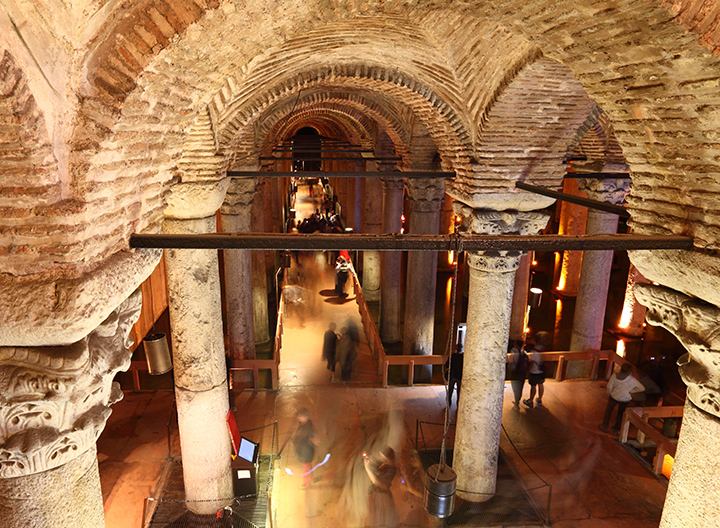Fatih
Fatih Today

Eminönü that is a neighborhood of Fatih district today became a district in 1928 when Istanbul Central district was separated into two. Fatih was a branch in the central district of Istanbul. With a reorganization on March 8th, 1984 Istanbul was transformed into Metropolitan Municipality while Fatih was made a district municipality under the Metropolitan Municipality. However, with law numbered 5747 (*) that entered into force on March 29th, 2009, two districts of the historic peninsula were unified under a single district under the name “Fatih”.
Historic peninsula Fatih neighbors Eyüp district to the North, the Golden Horn to the Northeast, Marmara Sea to the South, Zeytinburnu district to the West and Bayrampaşa district to the Northwest and lies in the region known as the Walled City (Suriçi). Fatih district has 57 neighborhoods.
Fatih district is based on an area of 15.6 km2 and according to the census conducted in 2008 through Address-Based Population Registration System it has a population of 443,955. (Based on census dated 2000 Fatih had a population of 403,508 and Eminönü had a population of 55,635.) Population per square kilometer is 28,458.
Occupying the entire Historic Peninsula, Fatih is named after the Ottoman sultan that conquered the city in 1453, Mehmed the Conqueror. Fatih started to develop around the Fatih Mosque that was constructed on the fourth hill of Istanbul with order of Sultan Mehmet the 2nd after conquest of Istanbul and in a short time it adopted the character of a classical Ottoman-Turkish city. With its wooden houses, mosques, Muslim theological schools, primary schools, and fountains Fatih is a center displaying the finest examples of Ottoman-Turkish lifestyle and architecture. Next to this mystical aura, Fatih also hosts select monuments of very significant civilizations such as Rome and Byzantium. Due to its characteristics, Fatih is also known as “the First Istanbul” or “the Real Istanbul”.

Historic Peninsula Fatih was one of the most important centers of the Roman Empire while it also served as the capital city of Byzantium for 1058 years and the Ottoman State for 469 years. Thus, it is possible to see many significant monuments from these three civilizations in the Historic Peninsula.
However, thanks to the most recent findings discovered during the Marmaray Project in Yenikapı, it was detected that the district was 8500 years old. These findings that would lead to rewriting of the known world history increased historic and cultural significance of Fatih.
* According to paragraph 2 of article 2 of Law numbered 5747 on Establishing District in Metropolitan Municipality Borders and Making Changes in Some Laws, Eminönü district was abolished and based on paragraph 1 of transitory article 2 of the same law, the legal person of Eminönü Municipality was annulled and it was included in Fatih Municipality with its neighborhoods.

Historic Monuments
Having the oldest residential areas of the city, Fatih district is quite rich in terms of historic monuments. It lost none of its charm in Byzantine, Ottoman, and the Republican periods and hosts very important historic and touristic monuments in its boundaries. Some of such rare monuments not just in Turkey but in the entire world are as follows:
· Pertevniyal (Aksaray) Valide Sultan Mosque
· Prison of Anemas and Towers
· Hagia Irene Church
· The Hagia Sophia Grand Mosque
· Hagios Georgios Patriarchal Church
· Beyazıt Mosque
· Beyazıt Square
· Cistern of Aspar
· St. Stephen (Bulgarian Iron) Church
· Bulgur Palas
· Serpent Column
· Column of Constantine
· Dar'ül Muallimat (Çapa Anatolian Teacher High School)
· Obelisk
· Fatih Mosque
· Fener Greek Boys High School
· Gülhane Park
· Hırka-i Şerif Mosque
· Chora Monastery
· İstanbul University
· Grand Bazaar
· Kariye Mosque
· Column of Marcian
· Little Hagia Sophia Mosque
· Laleli Mosque
· Melandisia (Mevlana) Gate
· Spice (Egyptian) Bazaar
· Mihrimah Sultan Mosque
· Nuruosmaniye Mosque
· Walled Obelisk
· Pertevniyal Valide Sultan Fountain
· Sultanahmet Mosque
· Sultanahmet Square
· Süleymaniye Mosque
· Şehzade Mosque
· Palace of the Porphyrogenitus
· Topkapı Palace
· Aqueduct of Valens
· Yavuz Sultan Selim Mosque
· Yedikule Fortress and Dungeons
· Yeni Mosque
· Yerebatan Palace (Cistern)
· Zeyrek Mosque (Pantocrator Church)
· Zeyrek (Pantocrator) Cistern

Geographical Location and Features
The most significant historic location that played an important role in bringing Istanbul forward in global scale and had an effective part in formation of city identity is the Historic Peninsula where the said cultural is intensely accumulated. The Historic Peninsula (Walled City - Suriçi) covers an area of total of 1562 hectares. Fatih lies between 41˚02' North and 28˚55'34 East.
Fatih neighbors Eyüp district to the North, the Golden Horn to the Northeast, Marmara Sea to the South, Zeytinburnu district to the West and Bayrampaşa district to the Northwest.
Ayvansaray, Balat, Yavuz Sultan Selim, Cibali, Yavuz Sinan, Sarı Demir, Rüstem Paşa, Hobyar, and Hocapaşa neighborhoods are lined up from North to South-Southeast. In East, there is Cankurtaran neighborhood at Sarayburnu (eastern tip); Sultanahmet, Küçük Ayasofya, Sehsuvarbey, Muhsine Hatun, Nişanca, Katip Kasım, Aksaray, Cerrahpaşa, Kocamustafapaşa, and Yedikule Neighborhoods at Marmara shore. Fatih district has Sümbülefendi, Silivrikapı, Mevlanakapı, Topkapı, Karagümrük, and Derviş Ali neighborhoods in the West. The district has a total of 57 neighborhoods.
Its elevation from sea level is 60 m on average. It has no agricultural land.
The Historic Peninsula is established on seven hills. There are poems written on the seven hills of Istanbul that are in Fatih borders.
1- The hill on which Topkapı Palace, Hagia Sophia Grand Mosque, and Sultanahmet Mosque are established.
2- The hill on which Column of Constantine and Nuruosmaniye Mosque are established.
3- The hill on which Beyazıt Mosque, Istanbul University, and Süleymaniye Mosque are established.
4- The hill on which Fatih Mosque is established.
5- The hill on which Yavuz Selim Mosque is established.
6- The hill at Edirnekapı neighborhood where Mihrimah Sultan Mosque is established.
7- The hill on which Kocamustafapaşa neighborhood is established.

One of the oldest districts of Istanbul, borders of Fatih are demarcated by the historic walls, Golden Horn and Marmara Sea. Some part of the city walls that extend from Ayvansaray on the Golden Horn to Yedikule are renovated and separate Fatih from Eyüp and Zeytinburnu districts. The sea walls on the Golden Horn and Marmara shores were destroyed to a large extent and could not stay intact to our day.
3 main streets ensuring transportation in Istanbul pass through Fatih district. These are Macar Kardeşler and Fevzi Paşa Streets that lie from Saraçhane to Edirnekapı, Vatan Street that connects Aksaray to Topkapı, and Millet Street that again connects Aksaray to Topkapı. Millet Street unites with Ordu Street to reach Eminönü neighborhood. Shore road passes on Marmara shore connecting Sirkeci to Bakırköy (Kennedy Street). The railroad that connects Istanbul to Europe and ensures suburban transportation on the western part of the city also runs parallel to this street. Also tram line enables access to Karaköy, Atatürk Airport, Yenibosna, and Esenler Bus Stop.
In 1950, Fatih district (excluding Eminönü) had a population of 226,853 and in 2000 its population reached 403,508 persons. Population increase at the district continued until 1975 and started to decrease after this date. In 1975, Fatih district had a population of 504,127 that increased to 403,508 in 2000. According to census results conducted through Address-Based Population Registration System Fatih had a population of 443,955 in 2008 (including Eminönü).








